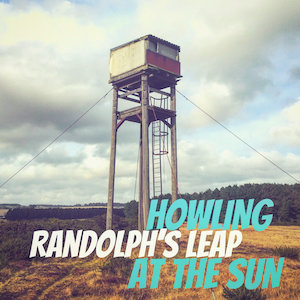 Randolph’s Leap – Howling at the Sun
Randolph’s Leap – Howling at the Sun
Independent – Out Now
Randolph’s Leap frontman Adam Ross is not the sort of musician to be put off his work by a global emergency and months of isolation. Instead of kicking back and celebrating ten years of life in one of Scotland’s most witty, wistful and well-loved indie-pop groups, he has decided to use his time away from his bandmates to curate and re-record a selection of the band’s extensive and impressive back-catalogue. Everything on Howling At The Sun was recorded at Ross’s home in April during the most intensive stage of the lockdown, and all but one of the songs are re-workings of older material. As you’d expect, it’s essentially a solo record (Ross plays every instrument; the only outside help comes in the form of his wife Michelle Watt on backing vocal duties), and the new setting, at once familiar and disarming, gives these songs a new lease of life.
Ross’s voice has always been the delicate heart at the centre of the band’s most arresting moments, and the DIY ethic of these recordings keeps that voice in the foreground while maintaining its vulnerability. Opener Cassie O’Tone has all the melodic sense of the original version and provides even more of an emotional hit.
The mode of recording might imply that this is an album of minimal, acoustic renditions. That’s not the case. Ross does an excellent job of recreating a full band (or almost full band) sound. The quite brilliant Conversation begins with little more than voice and guitar, but fills out a third of the way through, becoming something that, with its combination of organ and percussion, bears a passing resemblance to Positively 4th Street, while the ‘ooh, sha-la-la’ backing vocals reinforce the feel of 60s pop. A similar template is used for Electricity – a quiet start, a jolt of percussion, and an irresistible chorus.
Hide A Thing burns slower but just as bright, on a gauzy organ and a filigree of guitar, but the jauntiness and sense of fun that characterises the band is never far from to surface. It bubbles to the surface on the optimistic Suitable with its bright electric guitar solo. The Nonsense In My Soul marries the organ shimmer of early Camera Obscura with the bounce of Orange Juice or The Shop Assistants, while Petrichor is a brief vignette that makes a mockery of the idea that a good pop song needs to adhere to a certain structure of verse and chorus.
There are times when Ross mines the rich seam of Scotland’s jangle-pop heritage. Sunday Morning wouldn’t feel out of place on C86 or the Postcard label. But he seems equally influenced by the storytelling elements of folk music, particularly on the subtle closer Come Mid-Afternoon, which in this incarnation becomes a kind of hymn for isolation, lassitude and strangeness – lyrics like ‘it’s a funny time, but I don’t hear no laughter’ are uncannily close to capturing the spirit of our times.
There is one new track on Howling At The Sun: the long, lilting dream-song Hautausmaa. This too feels like a perfect encapsulation of the nostalgia and reverie that has proved to be an unexpected side-effect of the current situation. In fact, the whole album feels like the much-needed companion to a season of uncertainty and isolation: it is by turns sad, cheering and reflective, and full of the melodic inventiveness, the freshness and, ultimately, the positivity we have come to expect from Randolph’s Leap.

